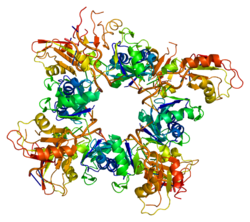Polyadenylate-binding protein 1 is a protein that in humans is encoded by the PABPC1 gene.[5] The protein PABP1 binds mRNA and facilitates a variety of functions such as transport into and out of the nucleus, degradation, translation, and stability. There are two separate PABP1 proteins, one which is located in the nucleus (PABPN1) and the other which is found in the cytoplasm (PABPC1). The location of PABP1 affects the role of that protein and its function with RNA.[6]
- ^ a b c GRCh38: Ensembl release 89: ENSG00000070756 – Ensembl, May 2017
- ^ a b c GRCm38: Ensembl release 89: ENSMUSG00000022283 – Ensembl, May 2017
- ^ "Human PubMed Reference:". National Center for Biotechnology Information, U.S. National Library of Medicine.
- ^ "Mouse PubMed Reference:". National Center for Biotechnology Information, U.S. National Library of Medicine.
- ^ Grange T, de Sa CM, Oddos J, Pictet R (June 1987). "Human mRNA polyadenylate binding protein: evolutionary conservation of a nucleic acid binding motif". Nucleic Acids Research. 15 (12): 4771–87. doi:10.1093/nar/15.12.4771. PMC 305917. PMID 2885805.
- ^ Gray NK, Hrabálková L, Scanlon JP, Smith RW (December 2015). "Poly(A)-binding proteins and mRNA localization: who rules the roost?". Biochemical Society Transactions. 43 (6): 1277–84. doi:10.1042/BST20150171. PMID 26614673.




